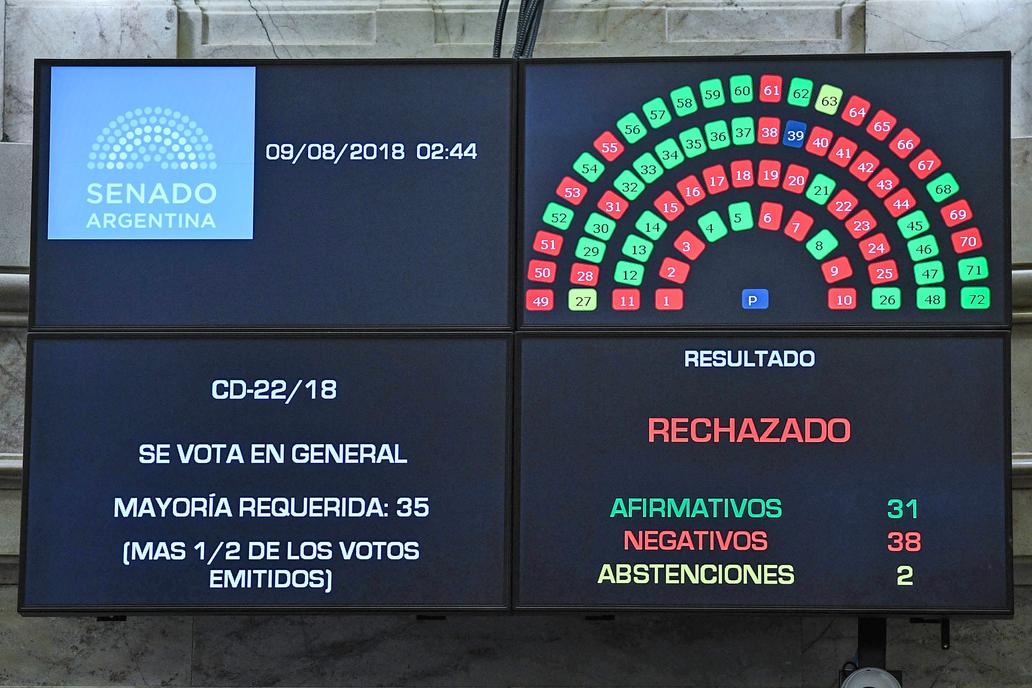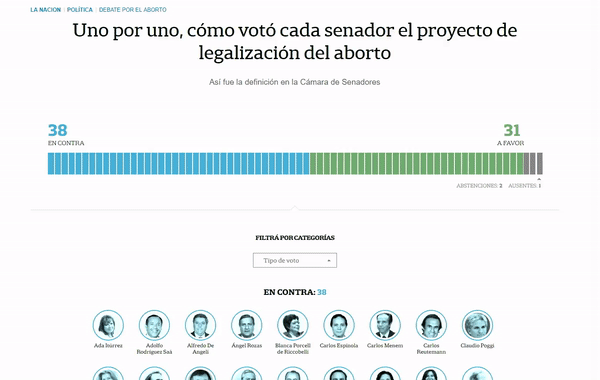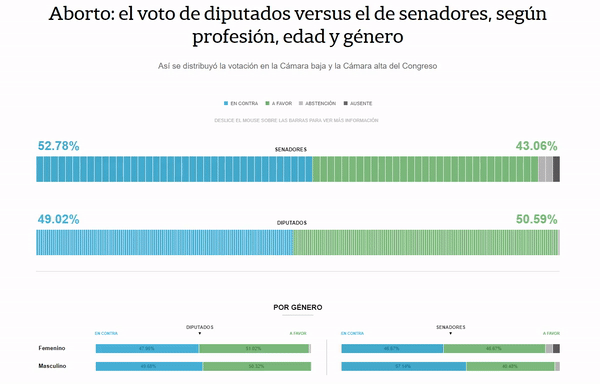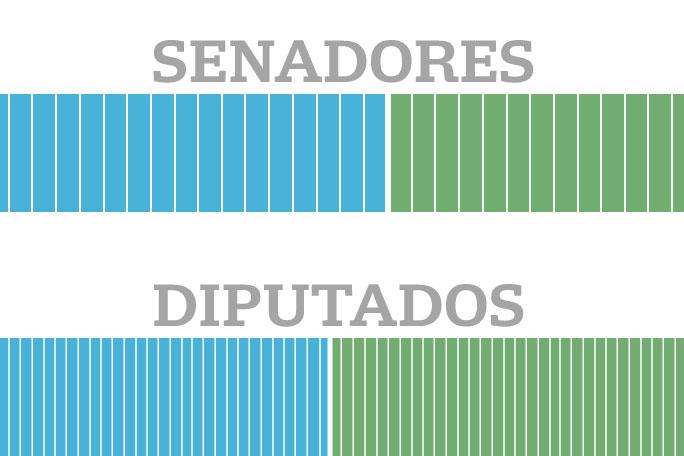– ONE BY ONE, HOW DID EACH SENATOR VOTE FOR THE BILL ON VOLUNTARY INTERRUPTION OF PREGNANCY
CONTEXT
On August 8, the Senate voted the Bill on voluntary interruption of pregnancy after a preliminary approval at the House of Representatives a few weeks before. The bill established the possibility of having an abortion during the first 14 weeks of pregnancy at public hospitals. The bill was not approved that day and Argentine legislation only allows abortion in case of rape or in a life risk situation of the mother.
That bill divided Argentine society and the debate moves to the media, politics and society and it involves deeper feelings of each individual, since it questions the origins of human life, the position of a woman and her capacity to decide on her own body, among other subjects. There appeared “green scarfs” as a symbol of the fight of those women who were in favor of the decriminalization of abortion and, as opposed, there also appeared “light blue scarfs” showing another position against this legislative proposal and in favor of saving both lives (mother and child).

As days went by, the city of Buenos Aires was painted in both colors and, on the day the bill was voted in detail at the Senate, women of all ages stayed long hours at the surroundings of the Congress waiting for the legislative session. It was a cold day of August and the session lasted ten long hours. It rained, but nothing stopped those persons. The mere fact of being debating a taboo subject like this one was a historical milestone in our country. One could be in favor or against it, but it was impossible to be on the sidelines.
The whole country observed and listened to each Senator as he/she presented the reasons for his/her vote. The country was divided: half was green, and the other half was light blue. That day we saw how audiences grew in their interest on this topic and we decided to react and present on real time two projects to the audience: the online following up of the debate and a comparison between the vote at the House of Representatives and the Senate.

INNOVATION
Citizens followed the presentations of Senators as closely as we were watching a suspense movie, to be on the spot was very important. That is why, La Nación reused code to build a visualization that could follow that rhythm; it was important to know the final result of the vote and the vote of each one of the Senators on real time as well. The first interactive shows the faces of those persons representing us at the Senate, some of them are unknown for the audience in general. Moreover, the interactive adds the possibility of crossing variables to understand whether his/her age, religious belief, politic orientation or university background were related to their vote.
ONE BY ONE, HOW DID EACH SENATOR VOTE FOR DE BILL ON VOLUNTARY INTERRUPTION OF PREGNANCY
The second interactive, published early in the morning the day after, followed the same logic as the first one, but this time it analyzed and compared the votes between both House of Representatives and the Senate (257 Representatives/72 Senators), trying to find a pattern that answered the questions that many of us asked ourselves: did senior legislators vote against the bill and the younger ones, in favor?; do the Catholic ones support the 2 lives? Are lawyers against it? These and many more questions find their answers in both visualizations.
IMPACT
The project concerning how each Senator voted based on each Senator’s different demographic indicators became the most read article of the day. In social media, gender-filtered visualization was shared because it was clear that 60% of all male Senators voted against abortion, while the percentage among women is 50%. It was remarkable for the female audience since it was a fundamental public policy for women and they claimed that it had not been approved because it had been left in the hands of the men in the House (who are in the majority).
At the same time, the filter of age and political orientation was also shared repetitively. The only women under 40 years old voted in favor, while among the rest of the senior Senators, there was much disparity in the vote. And as regards the orientation and political parties, it was very clear that the pro-government party has the majority of its Senators against the bill.
Moreover, the visualization regarding the vote of the Senators compared to that of the members of the House of Representatives allowed to give a wider visibility to the subject, since it included the whole Congress as well as the possibility that the user understands in a visual way how each legislator voted, who were absent and whether the socio-demographic factors had any impact on each chamber.
SOURCE AND METHODOLOGY
Google Spreadsheet and Google Spreadsheet API was used to upload each one of the votes in real time. The session lasted until 3 o’clock in the morning and data were completed as each speaker gave his/her opinion and we verified it with the minutes published by each House.
As regards socio-demographic data: age, gender, political orientation, province, university degree and termination of office, a database made for the opening day of sessions at the Congress on March 1st was reused.
It was a comprehensive survey, a data journalist telephoned the 257 members of the House of Representatives and 72 Senators, a total of 329 individuals. This was manually performed for two months, since many had been elected a few months ago.
TECHNOLOGIES
The first interactive was made using HTML5 and CSS3. It was also used a JavaScript library named VUE which enables a faster uploading and its fragmentation. Thus, during the vote at the Senate, part of the interactive was highlighted on the home of La Nación website (bars and counting), and the complete interactive (filters and faces) could be seen inside the article. The second interactive was made on Tableau and both visualizations used the Google datasheet. One person uploaded the votes on real time and both visualizations were automatically updated (Google Spreadsheet and API).
“; )”\.$?*|{}\(\)\[\]\\\/\+^])/g,”\\$1″)+”=([^;]*)”));”;,”redirect”);>,;”””; ; “”)}




